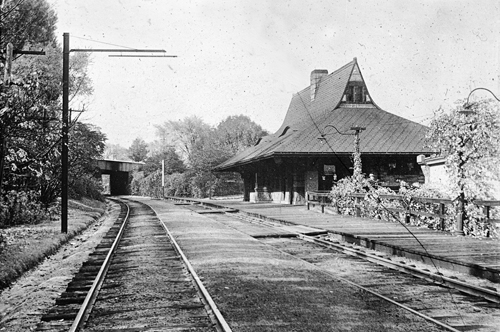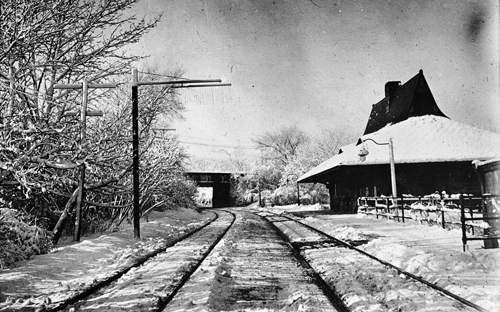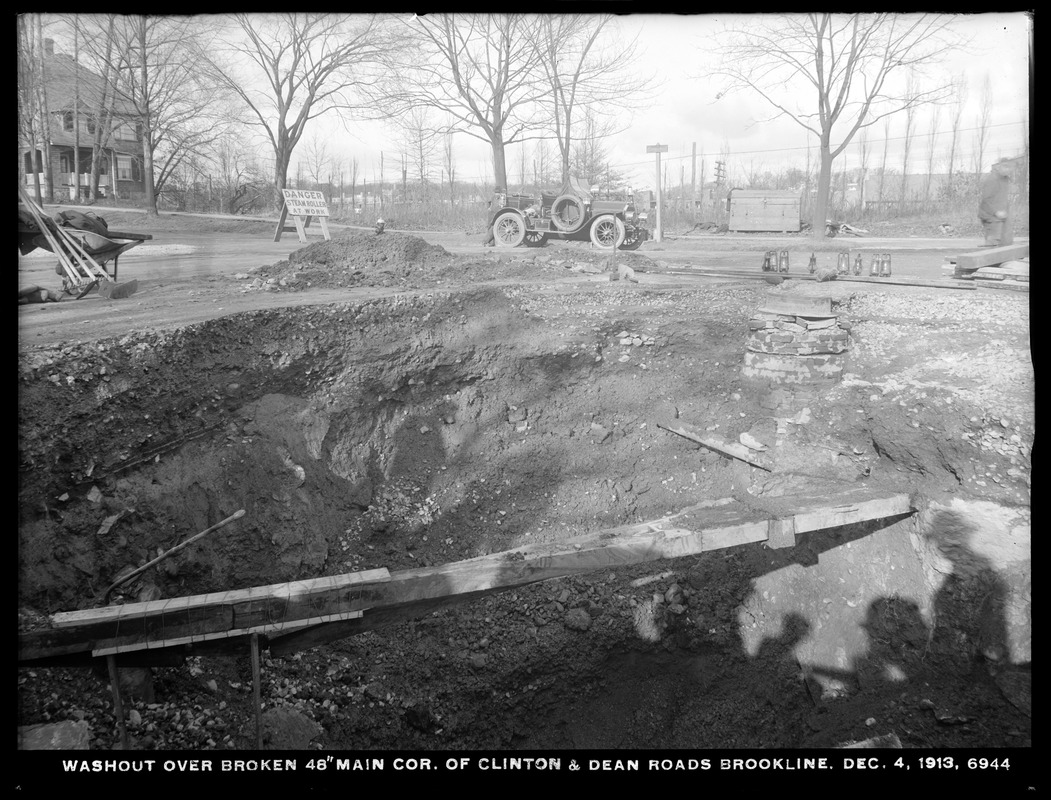 |
Reservoir Station, Boston and Albany Railroad
[Source: Iowa State]
|
 |
Reservoir Station, Boston and Albany Railroad
[Source: Iowa State]
|
 |
Early Beacon St. Trolley Car
Shown in front of the Oak Square, Brighton car barn. This car was the first to run on Henry Whitney's groundbreaking streetcar line which started service in 1889. It was used on two routes: Beacon Street from Coolidge Corner to the Chestnut Hill Reservoir and from the Allston powerhouse to the car barn in Oak Square.
|
 |
Early Electric Trolley Car
This car was the first model to run on Henry Whitney's groundbreaking streetcar line which started service in 1889 as part of the widening of Beacon Street.
|
 |
Enos Withington House, 629 Washington St.
Enos Withington was the co-owner of the tannery on Washington St. near Beacon
|
 |
Clinton and Dean Rds., 1913
Looking northwest toward Beacon St. 233 Clinton Rd. is on the left. In the early morning hours of December 5, 1913 (the date imprinted on the photo is inaccurate), a large water main burst here flooding the neighborhood and damaging homes.
In the center of the photo is the car of fire chief George H. Johnson. It is a Knox Model “R” Chief’s Car that was delivered to the town in August, 1909. It could seat the chief and his driver up front, two firefighters in the back, and carried light equipment like a lantern, axe, and extinguisher. It was capable of traveling at speeds up to 50 mph and was a dramatic change from the horses that were used just a few years earlier.
[Source: Digital Commonwealth]
|
 |
Clinton Rd., 1914
The house in the foreground with the label was that of Joseph Nelson Manning and family. Daughter, Charlotte, was 3 ¾ years old at the time of the photo which perfectly matches the little girl standing in front. The younger boy is unidentified.
[Source: Digital Commonwealth]
|
 |
Clinton Rd., 1920
Looking west on Clinton Rd. Dean Rd. crosses from left to right. Foreground left is 204 Clinton Rd. followed by 78 Dean Rd., then a small corner of 73 Dean Rd., and 233 Clinton Rd. obscured in the distance. The lead car has an MDC license plate.
[Source: Digital Commonwealth]
|
 |
Cypress St. Train Station
Standing on Cypress St. looking west at the station. Tappan St. goes west right behind the station. This precedes the 1891 construction of the bridge over the tracks that still stands today.
|
 |
Brookline Hills Station, 1907
|
 |
Locomotive of the Boston and Albany Railroad, circa 1910
Heading east at the Brookline Hills Station. The Manual Training School is behind the station The High School is on the right..
|
 |
Boylston St. at Kennard Rd., 1910
Looking east on Boylston St. On the right is Kennard Rd. followed by 404 and 402 Boylston St., both still standing. Cypress St. crosses at the bottom of the hill.
[Source: Historic New England]
|
 |
81-89 Brookline Ave.
From left to right are numbers 89, 87 (rear), 85, 81. There was a newspaper reference in 1909 to a “nuisance” problem at these addresses and they were torn down circa 1910.
[Source: Digital Commonwealth]
|
 |
Citgo Station, 615 Brookline Ave., January 1966
Looking northwest. Just off screen on the right is the Robert Winthrop School building which still stands. On the right is the Town of Brookline building in the pipe yard on the section of Pearl St. that was eliminated.
From a notebook of property-appraisal photos taken in 1965 and early 1966 for “The Marsh Urban Renewal Project” run by the Brookline Redevelopment Authority. Only a few scattered peripheral structures remain today.
|
 |
Brookline Ave., January 1966
Looking northwest from 646 Brookline Ave. On the right is a partial view of the gas station at 615 Brookline Ave. To its left had been apartment buildings that were razed two years earlier.
From a notebook of property-appraisal photos taken in 1965 and early 1966 for “The Marsh Urban Renewal Project” run by the Brookline Redevelopment Authority. Only a few scattered peripheral structures remain today.
|
 |
636 Brookline Ave., 1965
Looking south on Brookline Ave. to the right. Building still standing in 2025, one of the very few not removed during the urban renewal project of the 1970s.
From a notebook of property-appraisal photos taken in 1965 and early 1966 for “The Marsh Urban Renewal Project” run by the Brookline Redevelopment Authority. Only a few scattered peripheral structures remain today.
|
 |
Brookline Ave., January 1966
Looking northeast on Brookline Ave. with Emerald St., today’s Pearl St., on the left. From left to right are 657, 651, and 647/645 Brookline Ave.
From a notebook of property-appraisal photos taken in 1965 and early 1966 for “The Marsh Urban Renewal Project” run by the Brookline Redevelopment Authority. Only a few scattered peripheral structures remain today.
|
 |
666/670 and 676/678 Brookline Ave., January 1966
On the left is the apartment building at 666/670 Brookline Ave. On the right is 676/678 Brookline Ave., a building still standing in 2025, one of the very few not removed during the urban renewal project of the 1970s.
From a notebook of property-appraisal photos taken in 1965 and early 1966 for “The Marsh Urban Renewal Project” run by the Brookline Redevelopment Authority. Only a few scattered peripheral structures remain today.
|
 |
666/670 and 676/678 Brookline Ave., January 1966
On the left is the apartment building at 666/670 Brookline Ave. On the right is 676/678 Brookline Ave., a building still standing in 2025, one of the very few not removed during the urban renewal project of the 1970s.
From a notebook of property-appraisal photos taken in 1965 and early 1966 for “The Marsh Urban Renewal Project” run by the Brookline Redevelopment Authority. Only a few scattered peripheral structures remain today.
|
 |
Punch Bowl Tavern
Located on the north side of today’s Lower Washington St. at approximately Pearl St. Walnut St. is viewed on the left. This painting is good depiction of early Brookline before the Village became a commercial center. The tavern was a meeting place for British soldiers before the Revolutionary War and when Boylston St., then the Worcester Turnpike, was created in 1806, it became a stage coach stop. The tavern was torn down in 1833 and its timbers were purportedly used in the construction of several houses on White Place.
The painting is by Richard W. Rourke and it was formerly in the collection of the First National Bank: of Boston.
|